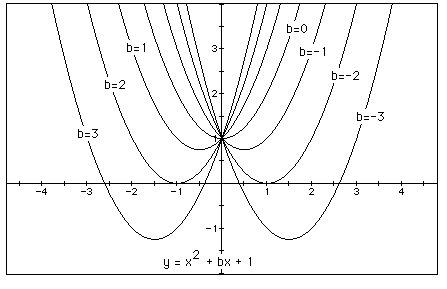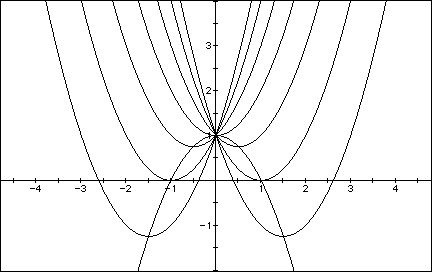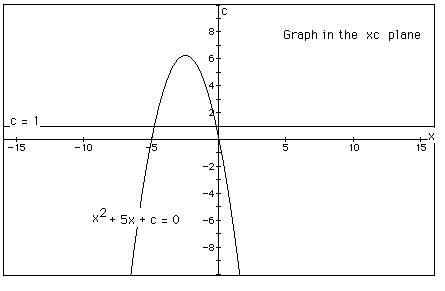
EMAT 6680 Assignment 3
By:
James W. Wilson and Keith Schulte
University of Georgia
Last modified on June 30, 2003.
Some Different Ways to Examine

It has now become a rather standard exercise, with available technology, to construct graphs to consider the equation
![]()
and to overlay several graphs of
![]()
for different values of a, b, or c as the other two are held constant. From these graphs discussion of the patterns for the roots of
![]()
can be followed. For example, if we set
![]()
for b = -3, -2, -1, 0, 1, 2, 3, and overlay the graphs, the following picture is obtained.

We can discuss the "movement" of a parabola as b is changed. The
parabola for tthis equation, always passes through the same point on the y-axis
( the point (0,1 . For b < -2 the parabola will intersect the x-axis in two
points with positive x values (i.e. the original equation will have two real
roots, both positive). For b = -2, the parabola is tangent to the x-axis and so
the original equation has one real and positive root at the point of tangency.
For -2 < b < 2, the parabola does not intersect the x-axis -- the
original equation has no real roots. Similarly for b = 2 the parabola is
tangent to the x-axis (one real negative root) and for b > 2, the parabola
intersects the x-axis twice to show two negative real roots for each b.
Now consider the locus of the vertices of the set of parabolas graphed from
![]() .
.
Show that the locus is the parabola
![]()
Generalize.

Graphs in the xb plane.
Consider again the equation
![]()
Now graph this relation in the xb plane. We get the following graph.

If we take any particular value of b, say b = 3, and overlay this equation on the graph we add a line parallel to the x-axis. If it intersects the curve in the xb plane the intersection points correspond to the roots of the original equation for that value of b. When we let b = 3, we have two roots and both are negative. The roots are approximately -.382 and -2.618. In the following graph, the red line represents b=3. We can see that it intersects in two places and that both are negative.

For each value of b we select, we get a horizontal line. It is clear on a
single graph that we get two negative real roots of the original equation when
b > 2, one negative real root when b = 2, no real roots for -2 < b <
2, One positive real root when b = -2, and two positive real roots when b <
-2.
Consider the case when c = - 1 rather than + 1, if we let b=3, we would get the
following graph. Once again, the
red line represents b=3. With c= -1, we see that our new equation,
![]()
has a different orientation. When b=3, the new equation, returns one positive root at about .303 and one negative root at about -3.003.

Graphs in the xc plane.
In the following example the equation
![]()
is considered. If the equation is graphed in the xc plane, it is easy to see that the curve will be a parabola. For each value of c considered, its graph will be a line crossing the parabola in 0, 1, or 2 points -- the intersections being at the roots of the original equation at that value of c. In the graph, the graph of c = 1 is shown. The equation
![]()
will have two negative roots -- approximately -0.2 and -4.8.

There is one value of c where the equation will have only 1 real root -- at c = 6.25. For c > 6.25 the equation will have no real roots and for c < 6.25 the equation will have two roots, both negative for 0 < c < 6.25, one negative and one 0 when c = 0 and one negative and one positive when c < 0.
Return to Keith Schulte's homepage.
Return to EMAT 6680 Home Page